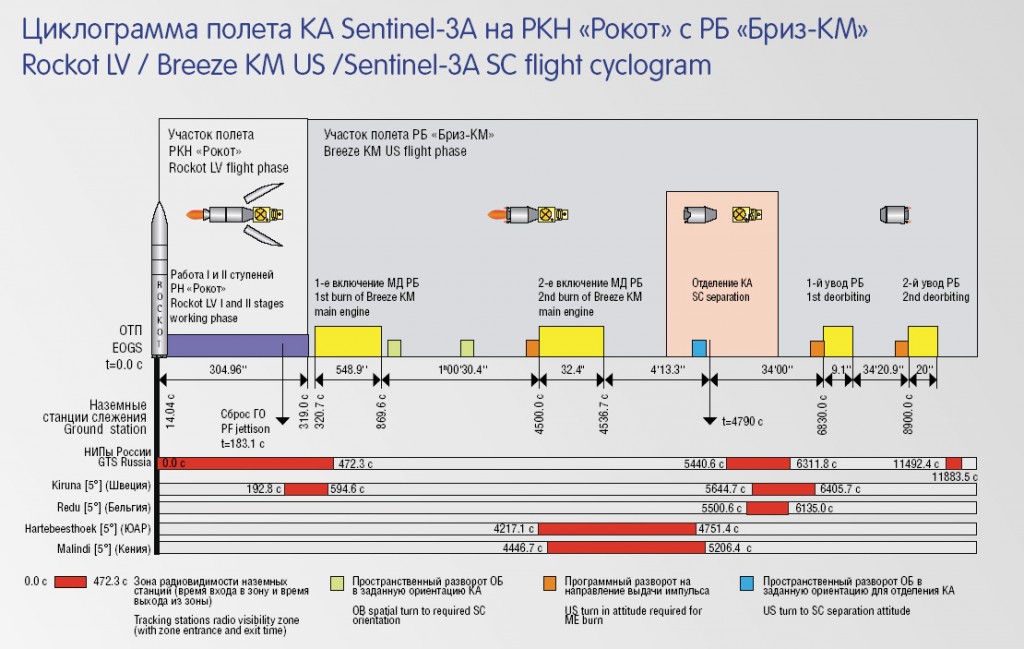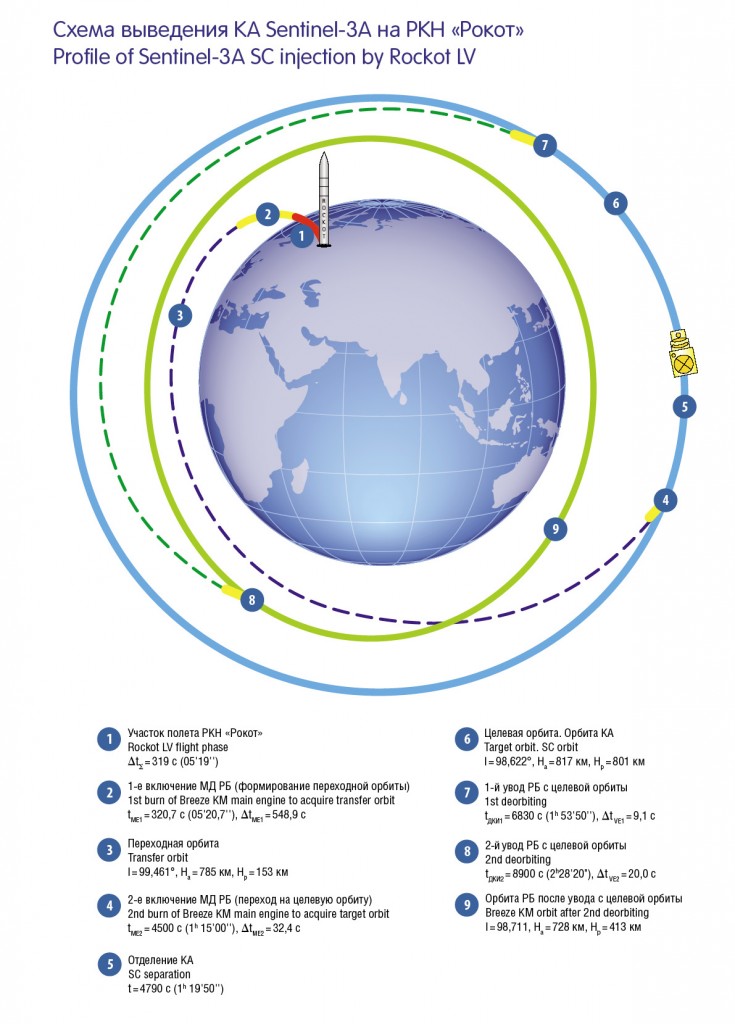Sentinel-3 Launch Profile
>>Rockot Launch Vehicle Overview
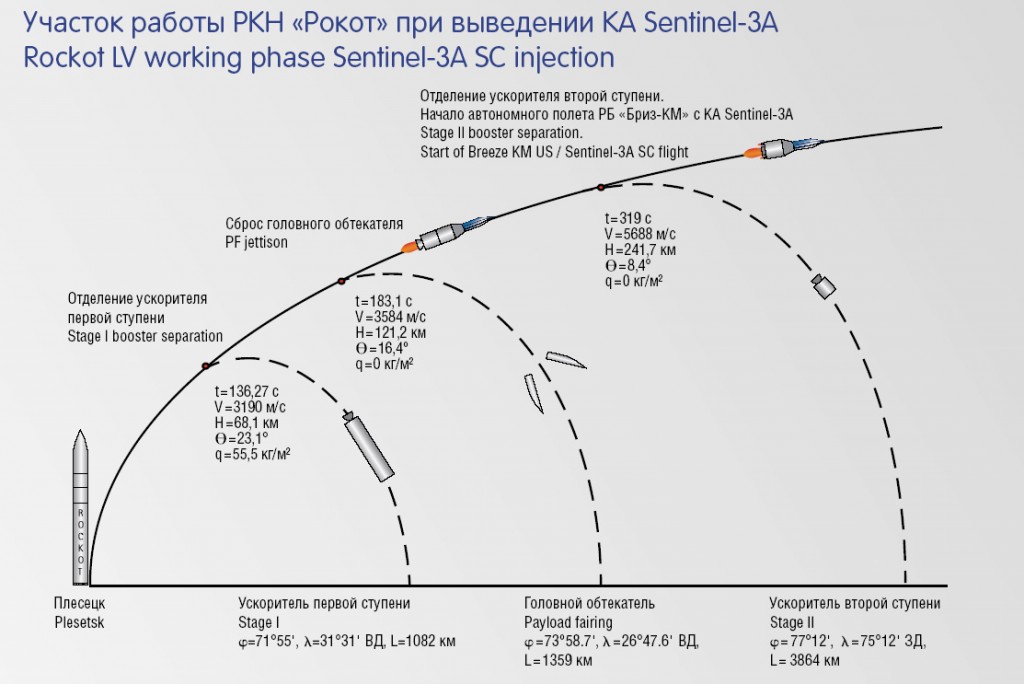
Launch Timeline
| Time | Event | Altitude(km) | Velocity (m/s) |
|---|---|---|---|
| T-0 | End of Gyro Settling (Nav System initialized for Flight) | ||
| T+0:00:11 | First Stage Ignition | ||
| T+0:00:14 | Liftoff Signal | ||
| T+0:01:04 | Maximum Dynamic Pressure | 10.7 | 570 |
| T+0:02:13 | RD-0236 Second Stage Vernier Ignition | ||
| T+0:02:16 | First Stage Shutdown | 68.1 | 3190 |
| T+0:02:16 | Stage Separation (Alt: 68km) | ||
| T+0:02:20 | Second Stage Main Engine Ignition | ||
| T+0:03:03 | Payload Fairing Jettison | 121.2 | 3584 |
| T+0:03:13 | Kiruna - Acquisition of Signal | ||
| T+0:05:19 | Second Stage Separation | 241.7 | 5688 |
| T+0:05:25 | Briz-KM Vernier Ignition for Propellant Settling | ||
| T+0:05:29 | First Briz-KM Ignition - Burn: 9min 8.9sec | ||
| T+0:07:52 | Ground Tracking Network - Loss of Signal | ||
| T+0:09:55 | Kiruna - Loss of Signal | ||
| T+0:14:30 | Briz-KM Shutdown | 153 | |
| T+0:14:30 | Coast Phase (Duration: 60:34) | ||
| T+1:02:30 | Re-Orientation to required S/C Attitude | ||
| T+1:10:17 | Hartebeesthoek - Acquisition of Signal | ||
| T+1:14:07 | Malindi - Acquisition of Signal | ||
| T+1:15:00 | Briz-KM Vernier Ignition for Propellant Settling | ||
| T+1:15:04 | Second Briz-KM Ignition - Burn: 32.4sec | ||
| T+1:15:37 | Briz-KM Shutdown | ||
| T+1:19:11 | Hartebeesthoek - Loss of Signal | ||
| T+1:19:50 | Spacecraft Separation | 801 | |
| T+1:26:46 | Malindi - Loss of Signal | ||
| T+1:30:41 | Russian Ground Station - Acquisition of Signal | ||
| T+1:31:41 | Redu - Acquisition of Signal | ||
| T+1:34:05 | Kiruna - Acquisition of Signal | ||
| T+1:40:15 | Redu - Loss of Signal | ||
| T+1:45:12 | Russian Ground Station - Loss of Signal | ||
| T+1:46:46 | Kiruna - Loss of Signal | ||
| T+1:53:50 | Briz-KM 1st Disposal Burn (Duration: 9.1 sec) | ||
| T+2:28:20 | Briz-KM 2nd Disposal Burn (Duration: 20 sec) | ||
| T+3:11:32 | Russian Ground Station - Acquisition of Signal | ||
| T+3:18:04 | Russian Ground Station - Loss of Signal |
Orbit Design
| Orbit | Apogee | Perigee | Inclination |
|---|---|---|---|
| Parking Orbit | 153 km | 785 km | 99.46° |
| Insertion Orbit | 801 km | 817 km | 98.62° |
| Disposal Orbit | 413 km | 728 km | 98.71° |
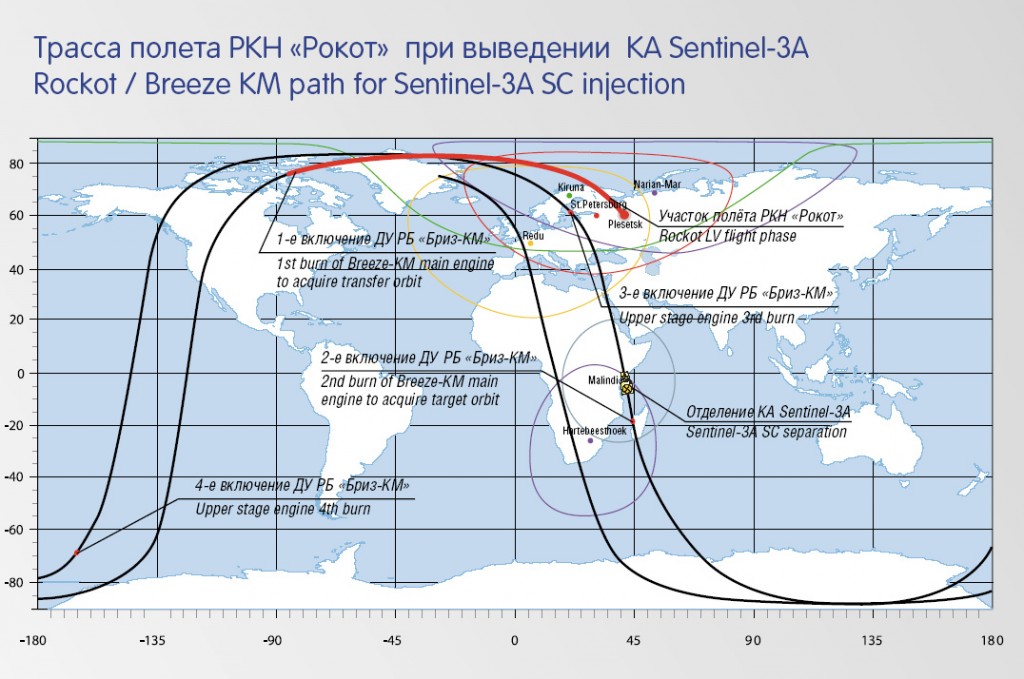
Countdown & Launch Sequence
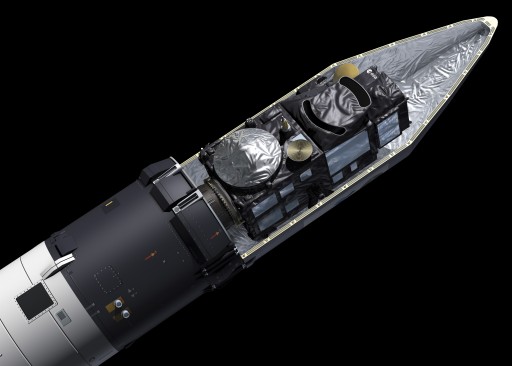
The European Sentinel-3A satellite, weighing in at 1,200 Kilograms, launches atop a Russian Rockot launch vehicle under operation by Eurockot. First flown in 1990, Rockot is a two-stage converted ballistic missile, outfitted with a Briz-KM Upper Stage to conduct multiple burns and insert spacecraft into a variety of orbits. Rockot stands 29.2 meters tall, has a diameter of 2.5 meters and weighs in at 107 metric tons, loaded with hypergolic propellants, Unsymmetrical Dimethylhydrazine and Nitrogen Tetroxide. The vehicle is capable of delivering 1,200 Kilograms to Sun Synchronous Orbit, making it suitable for advanced Earth Observation Satellites.
Spacecraft countdown operations start at T-7 hours. While Sentinel-3A completes final checkouts and reconfigurations, teams at the launch pad will be closing out the Rockot Transport and Launch Container and the Mobile Service Tower that will be removed shortly before launch. The Russian State Commission will meet at T-6 Hours to provide the official approval for final countdown operations.
The launch team will be putting Rockot through a series of checkouts after power-up and all tracking stations will be verified ahead of the final countdown sequence. With launch vehicle fueling completed at L-1 Day, the countdown does not include any dynamic events such as tanking.
Teams at the European Space Operations Center will be closely monitoring spacecraft telemetry and perform a GO/No GO Poll at T-60 minutes. By T-15 minutes, the Sentinel-3A satellite will be transitioned to its final launch configuration – on internal power and in flight mode. At T-3 minutes, the final countdown sequence gets underway during which Rockot completes the transfer to internal power and begins propellant tank pressurization for flight. The payload air conditioning system is deactivated at T-30 seconds.

When the launch countdown hits zero, Rockot begins its launch sequence with the reconfiguration of the inertial navigation system of the launcher, settling the gyroscopes to be ready deliver correct navigation data. First stage ignition occurs at T+11 seconds.
Liftoff from Site 133/3 comes at T+14 seconds as the powerful RD-0233/0234 engines on the first stage soar up to liftoff thrust – boosting the Rockot out of its Transport and Launch Container to start its climb. At the moment of liftoff, all umbilicals between the launcher and TLC are separated by mechanical systems. Following liftoff, the rocket performs a short vertical ascent before starting to pitch over and align itself with its launch trajectory, swinging to the north, headed for a high inclination orbit.
Rockot’s first stage is 17.2 meters long and holds 72,000 Kilograms of propellants that are consumed by three RD-0233 engines and a single RD-0234 for a total liftoff thrust of 190,700 Kilogram-force. The first stage separates from the second stage in hot-staging mode.
About 50 seconds after liftoff, Rockot experiences Maximum Dynamic Pressure as it climbs through 11 Kilometers in altitude and begins to race downrange, already past the speed of sound. At T+2 minutes and 16 seconds, the first stage of the vehicle shuts down, the RD-0236 vernier of the second stage will be firing at that point as part of the hot-staging process. At T+2:16, the separation system is fired and the spent first stage is pushed away by the exhaust of the vernier engine. Four small solid-fueled retrorockets on the first stage are fired to move it to a safe distance to the second stage that ignites its main engine at T+2:20.
Stage 2 is 3.9 meters long and has a fuel load of 10,700 Kilograms. It is powered by a single main engine - RD-0235, delivering 24,500 Kilogram-force of thrust. Vehicle steering is accomplished by gimbaling the four nozzles of the RD-0236 vernier engine that operates at a thrust of 1,600 Kilogram-force. The second stage main engine burns for 180 seconds while the small vernier operates 14 seconds longer.
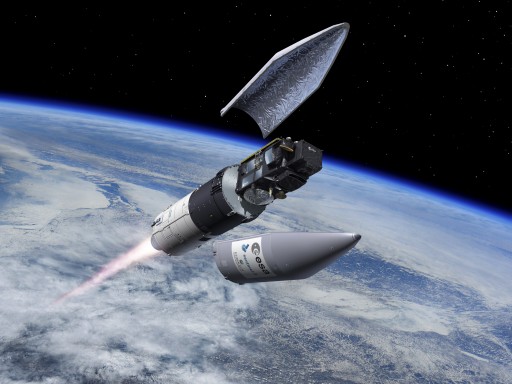
With the second stage firing, Rockot continues powered ascent and quickly departs the dense atmosphere. At T+3 minutes and 3 seconds, the Rockot jettisons its payload fairing that is 7.8 meters long and 2.5 meters in diameter, revealing the Sentinel-3A satellite for the rest of the ride to orbit.
At T+5 minutes and 19 seconds, the Orbital Unit consisting of the Briz-KM Upper Stage and the satellite is separated from the Booster into a sub-orbital trajectory. Briz-KM is 2.6 meters long and 2.5 meters in diameter with a launch mass of 12,200kg. The upper stage is equipped with a main propulsion system, vernier thrusters and an attitude control system. It features a single S5.98 engine that provides 2,000 Kilogram-force of thrust and can be ignited up to eight times to support complex mission profiles.
For Sentinel-3A, Briz-KM will perform two burns, the first just after separation from Rockot to achieve an elliptical Parking Orbit with the apogee matching the target altitude over 800 Kilometers. Another burn around apogee serves as circularization maneuver and delivers the stack to its planned insertion orbit.
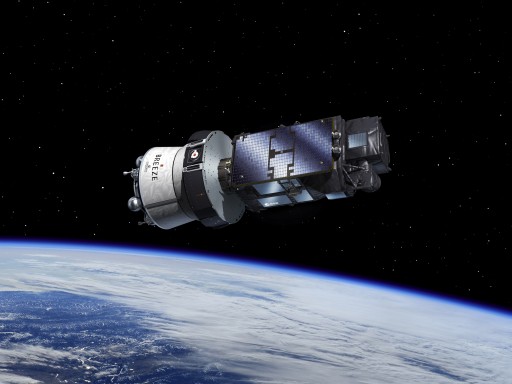
At T+5 minutes and 25 seconds, the Briz-KM Upper Stage ignites on its first engine burn to boost the stack into an elliptical Parking Orbit. This burn is planned to be 9 minutes and 9 seconds in duration, aiming for an orbit of 153 by 785 Kilometers at an inclination of 99.46°. This will set up a coast phase of one hour and 34 seconds, allowing Briz-KM to climb to the apogee of its preliminary orbit so that the second burn can act as circularization.
The second Briz-KM burn is planned to commence one hour, 15 minutes and 4 seconds into the mission, after the usual settling maneuver. S5.98 is expected to fire for 32.4 seconds to bring up the perigee and insert the stack into a nearly circular orbit. Sentinel-3A aims for an orbit if 801 by 817 Kilometers at an inclination of 98.62°.
Following separation, Sentinel-3A will be tasked with establishing a stable orientation, deploy its single solar array and check in with ground stations to deliver health data to teams at ESOC, marking the start of a three-day initial commission phase.
For Briz-KM, two disposal maneuvers are coming up after satellite deploy, a nine-second burn at T+1 hour 53 minutes and a 20-second maneuver two hours and 28 minutes into the mission, targeted a Briz-KM disposal orbit of 413 x 728 Kilometers, 98.71°.
